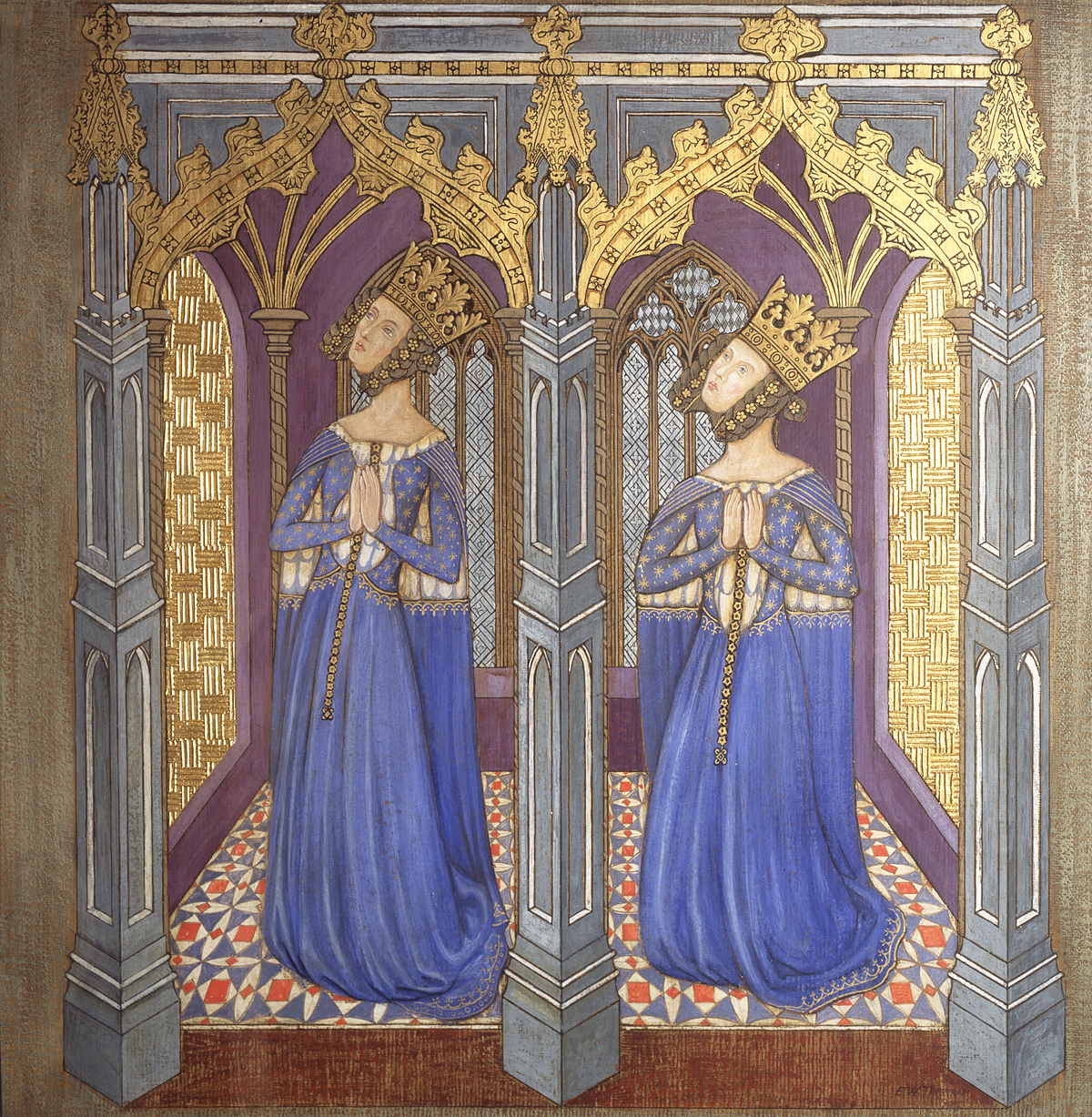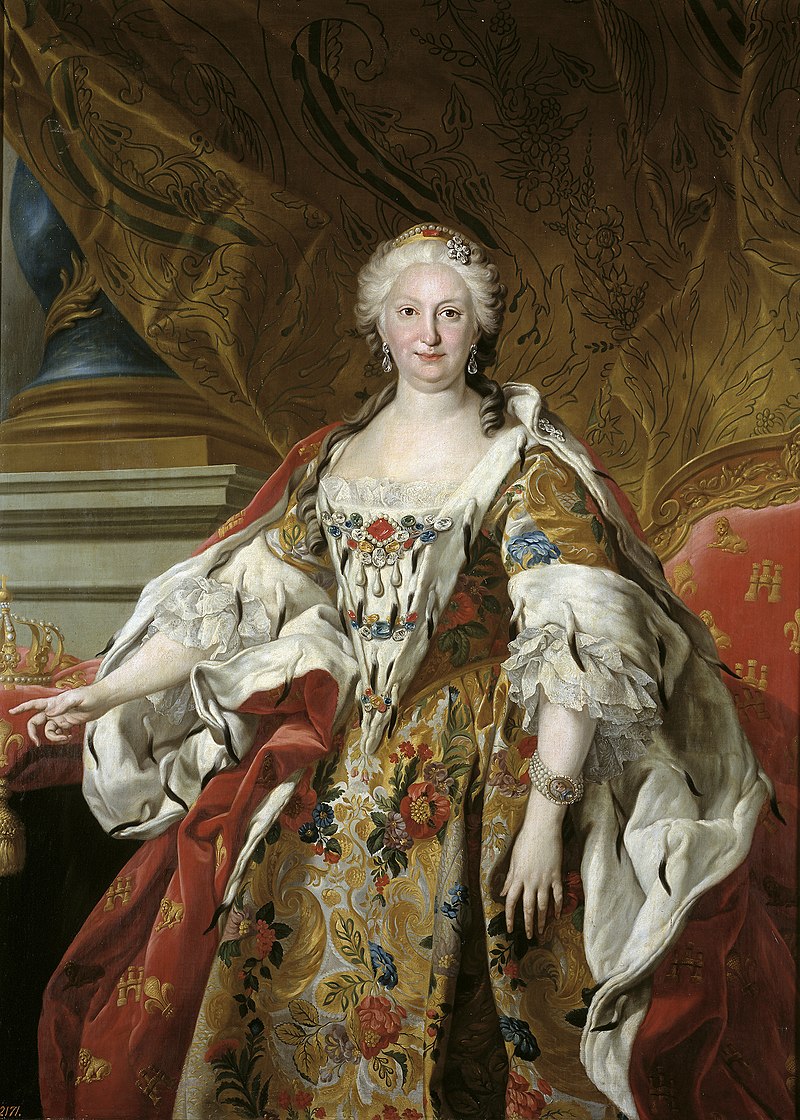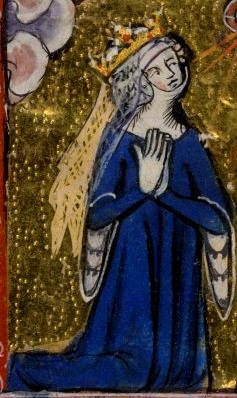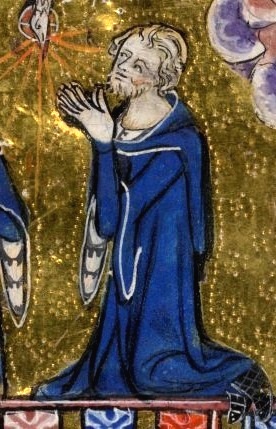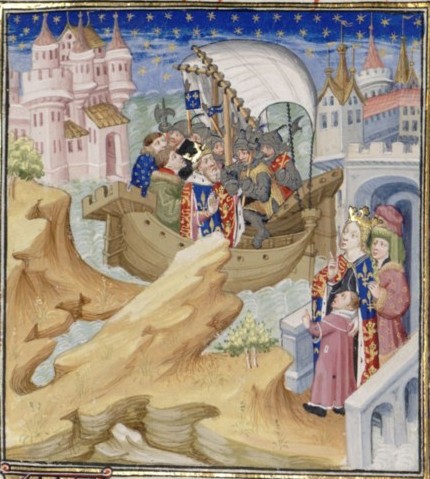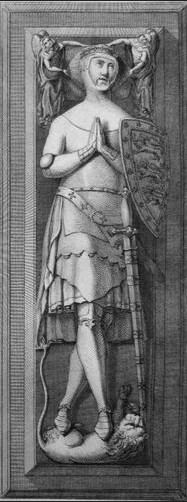by Susan Flantzer
© Unofficial Royalty 2023

Joan of England, sculpted on the tomb of her father King Edward III, from The Monumental Effigies of Great Britain drawn and etched by Thomas Hollis and George Hollis; Credit – Wikipedia
One of the early English victims of the bubonic plague, dying from it on her way to her wedding, Joan was the third of the fourteen children and the second of the five daughters of King Edward III of England and Philippa of Hainault. Her paternal grandparents were King Edward II of England and Isabella of France. Joan’s paternal grandparents were Willem I, Count of Hainault (also Count of Holland, Count of Avesnes, and Count of Zeeland) and Joan of Valois. The date and place of her birth have been cited differently. The years of her birth have been cited as 1333, 1334, or 1335. The Tower of London or Woodstock Palace has been cited as her place of birth. Alison Weir in her 1989 Britain’s Royal Families: The Complete Genealogy says, Joan “was probably born in February (certainly before 30 May), 1335 at Woodstock Palace in Oxford, not in the Tower of London as is sometimes stated.”
Joan had thirteen siblings. Her brothers married into the English nobility and it was their descendants who later battled for the throne in the Wars of the Roses. During the reign of the House of Plantagenet, their children were often identified by their place of birth, and so some of Joan’s siblings were called “of <their birthplace>.
- Edward, Prince of Wales, the Black Prince (1330 – 1376), married Joan, 4th Countess of Kent, had issue (King Richard II of England)
- Isabella of England (1332 – 1379) married Enguerrand VII de Coucy, 1st Earl of Bedford, had issue
- William of Hatfield (born and died 1337)
- Lionel of Antwerp, 1st Duke of Clarence (1338 – 1368), married (1) Elizabeth de Burgh, 4th Countess of Ulster, had issue (2) Violante Visconti, no issue
- John of Gaunt, 1st Duke of Lancaster (1340 – 1399), married (1) Blanche of Lancaster, had issue including King Henry IV of England (2) Infanta Constance of Castile, had issue (3) Katherine Swynford (formerly his mistress), had issue
- Edmund of Langley, 1st Duke of York (1341 – 1402), married (1) Infanta Isabella of Castile, had issue (2) Joan Holland, no issue
- Blanche of the Tower (born and died March 1342)
- Mary of Waltham (1344 – 1362), married John V, Duke of Brittany, no children
- Margaret of Windsor, Countess of Pembroke (1346 – 1361), married John Hastings, 2nd Earl of Pembroke, no children
- Thomas of Windsor (1347 – 1348), died of the plague
- William of Windsor (born and died 1348), died of the plague
- Thomas of Woodstock, 1st Duke of Gloucester (1355 – 1397), married Eleanor de Bohun, had issue

Woodstock Palace; Credit – Wikipedia
The family’s main home was Woodstock Palace in Oxfordshire, England. It was the favorite residence of Joan’s mother Philippa and the birthplace of several of her children. Joan, her sister Isabella, her brother Edward, and their first cousin once removed Joan of Kent (who married Joan’s eldest brother and is the mother of King Richard II) were sent to live in the household of Aymer de Valence, 2nd Earl of Pembroke and his second wife Marie de St Pol, Countess of Pembroke. It was common for royal and noble children to be raised for a period of time in another household.
In 1338, three-year-old Joan accompanied her father to Koblenz, a seat of the Holy Roman Emperor, now in Germany, where King Edward III was a special guest of Ludwig IV, Holy Roman Emperor, at a meeting of the Imperial Diet, the deliberative body of the Holy Roman Empire. King Edward III and Holy Roman Emperor Ludwig IV formally allied against King Philippe VI of France. Because Joan stayed at Ludwig’s court to be educated, she possibly was betrothed to one of the sons of Ludwig and his second wife Margaret of Hainault, the older sister of Joan’s mother. However, Ludwig broke his alliance with Edward III, and in 1340, Joan was returned to England.
In 1345, Joan was betrothed to the future King Pedro of Castile and León, the son of King Alfonso XI of Castile and León and Maria of Portugal. In the summer of 1348, thirteen-year-old Joan left England for Bayonne, Duchy of Gascony, now in France, where her wedding was to take place on November 1, 1348. Joan was accompanied by a heavily armed retinue and it was said that her trousseau alone required an entire ship.
The fleet of four English ships arrived in the port of Bordeaux, Duchy of Gascony, now in France. The mayor of Bordeaux warned the officials accompanying Joan of the Black Death, the bubonic plague. The plague had not yet reached England, and it is unlikely that the officials realized the danger. Joan’s retinue settled in a family castle in Bordeaux to take a planned break in their travels. Despite a serious outbreak of the plague in Bordeaux, it did not occur to Joan and the officials to leave the city. However, they soon watched in horror as members of Joan’s retinue fell ill and began to die. Robert Bauchier, the leader of Joan’s retinue, died on August 20, 1338. After the death of Robert Bauchier, Joan feared for her life and was moved to a small village called Loremo. However, Joan did not escape the plague and died on September 2, 1348.

Map showing the spread of the Black Death; Credit – By Flappiefh – Own work from:Natural Earth ;The origin and early spread of the Black Death in Italy: first evidence of plague victims from 14th-century Liguria (northern Italy) maps by O.J. Benedictow., CC BY-SA 4.0, https://commons.wikimedia.org/w/index.php?curid=66468361
Andrew Ulford, a member of Joan’s retinue who did not get the plague, traveled to England in October 1348 to inform King Edward III of the shocking news of his daughter’s death. On October 15, 1348, King Edward III sent a letter to King Alfonso XI of Castile annulling the marriage arrangement and describing the grief he and his family experienced after Joan’s sudden death. He described her as a martyred angel looking down on them from heaven to protect the royal family. On October 25, 1348, King Edward III sent men to Bordeaux to bring Joan’s body back to London for burial. It is unknown what happened. There is no record of the return of Joan’s remains to England and no reports of her burial.
This article is the intellectual property of Unofficial Royalty and is NOT TO BE COPIED, EDITED, OR POSTED IN ANY FORM ON ANOTHER WEBSITE under any circumstances. It is permissible to use a link that directs to Unofficial Royalty.
Works Cited
- Flantzer, Susan. (2015) King Edward III of England, Unofficial Royalty. Available at: https://www.unofficialroyalty.com/king-edward-iii-of-england/ (Accessed: November 23, 2022).
- Joan of England (died 1348) (2022) Wikipedia. Wikimedia Foundation. Available at: https://en.wikipedia.org/wiki/Joan_of_England_(died_1348) (Accessed: November 23, 2022).
- Иоанна Английская (1335-1348) (2021) Wikipedia (Russian). Wikimedia Foundation. Available at: https://ru.wikipedia.org/wiki/%D0%98%D0%BE%D0%B0%D0%BD%D0%BD%D0%B0_%D0%90%D0%BD%D0%B3%D0%BB%D0%B8%D0%B9%D1%81%D0%BA%D0%B0%D1%8F_(1335%E2%80%941348) (Accessed: November 23, 2022).
- Mortimer, Ian. (2006) The Perfect King: The Life of Edward III, Father of the English Nation. London: Vintage Books.
- Weir, Alison. (1989) Britain’s Royal Families: The Complete Genealogy. London: Vintage Books.
- Williamson, David. (1996) Brewer’s British royalty: A Phrase and Fable dictionary. London: Cassell.







